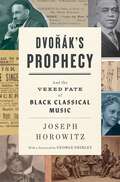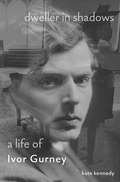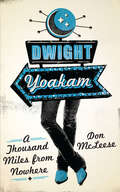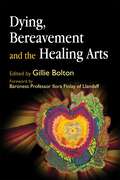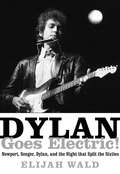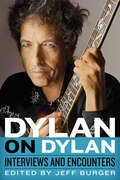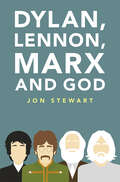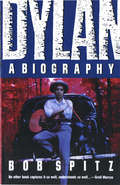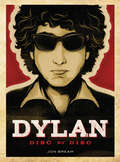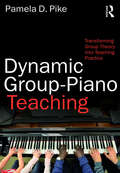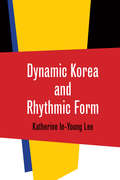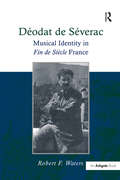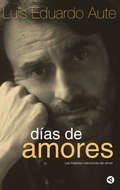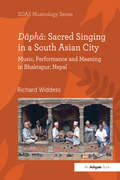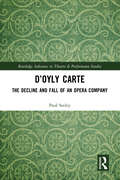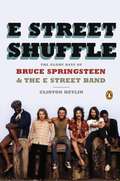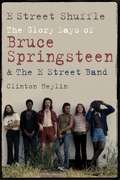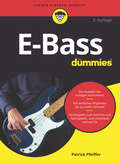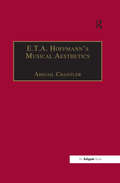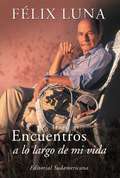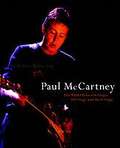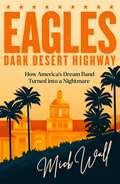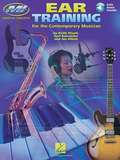- Table View
- List View
Dvorak's Prophecy: And The Vexed Fate Of Black Classical Music
by Joseph HorowitzA Kirkus Reviews Best Nonfiction Book of 2021 A provocative interpretation of why classical music in America "stayed white"—how it got to be that way and what can be done about it. In 1893 the composer Antonin Dvorák prophesied a "great and noble" school of American classical music based on the searing "negro melodies" he had excitedly discovered since arriving in the United States a year before. But while Black music would found popular genres known the world over, it never gained a foothold in the concert hall. Joseph Horowitz ranges throughout American cultural history, from Frederick Douglass and Huckleberry Finn to Gershwin’s Porgy and Bess and the work of Ralph Ellison, searching for explanations. Challenging the standard narrative for American classical music fashioned by Leonard Bernstein and Aaron Copland, he looks back to literary figures—Emerson, Melville, and Twain—to ponder how American music can connect with a "usable past." The result is a “new paradigm” that makes room for Black composers including Harry Burleigh, Nathaniel Dett, William Dawson, and Florence Price to redefine the classical canon.
Dweller in Shadows: A Life of Ivor Gurney
by Kate KennedyThe first comprehensive biography of an extraordinary English poet and composer whose life was haunted by fighting in the First World War and, later, confinement in a mental asylumIvor Gurney (1890–1937) wrote some of the most anthologized poems of the First World War and composed some of the greatest works in the English song repertoire, such as “Sleep.” Yet his life was shadowed by the trauma of the war and mental illness, and he spent his last fifteen years confined to a mental asylum. In Dweller in Shadows, Kate Kennedy presents the first comprehensive biography of this extraordinary and misunderstood artist.A promising student at the Royal College of Music, Gurney enlisted as a private with the Gloucestershire regiment in 1915 and spent two years in the trenches of the Western Front. Wounded in the arm and subsequently gassed during the Battle of Passchendaele, Gurney was recovering in hospital when his first collection of poems, Severn and Somme, was published. Despite episodes of depression, he resumed his music studies after the war until he was committed to an asylum in 1922. At times believing he was Shakespeare and that the “machines under the floor” were torturing him, he nevertheless continued to write and compose, leaving behind a vast body of unpublished work when he died of tuberculosis. Drawing on extensive archival research and spanning literary criticism, history, psychiatry and musicology, this compelling narrative sets Gurney’s life and work against the backdrop of the war and his institutionalisation, probing the links between madness, suffering and creativity.Facing death in the trenches, Gurney hoped that history might not “forget me quite.” This definitive account of his life and work helps ensure that he will indeed be remembered.
Dwight Yoakam: A Thousand Miles from Nowhere (American Music Series)
by Don McLeese&“[A] compulsively readable biography . . . Essential for fans of Yoakam and lovers of good music writing.&” ―Library Journal From his formative years playing pure hardcore honky-tonk for mid-&’80s Los Angeles punk rockers through his subsequent surge to the top of the country charts, Dwight Yoakam has enjoyed a singular career. An electrifying live performer, superb writer, and virtuosic vocalist, he&’s successfully bridged two musical worlds that usually have little use for each other: commercial country and its alternative/Americana/roots-rocking counterpart. Defying the label &“too country for rock, too rock for country,&” Yoakam has triumphed while many of his peers have had to settle for cult acceptance. Four decades into his career, he&’s sold more than twenty-five million records and continues to tour regularly. Now award-winning music journalist Don McLeese offers the first musical biography of this acclaimed artist. Tracing the seemingly disparate influences in Yoakam&’s music, McLeese shows how he&’s combined rock and roll, rockabilly, country, blues, and gospel into a seamless whole. In particular, McLeese explores the essential issue of &“authenticity&” and how it applies to Yoakam, as well as to country music and popular culture in general. Drawing on wide-ranging interviews with Yoakam and his management, while also benefiting from the perspectives of others closely associated with his success (including producer-guitarist Pete Anderson, partner throughout Yoakam&’s most popular and creative decades), Dwight Yoakam pays tribute to the musician who has established himself as a visionary beyond time, an artist who could title an album Tomorrow&’s Sounds Today and deliver it.
Dwight Yoakam: A Thousand Miles from Nowhere (American Music Series)
by Don McleeseFrom his formative years playing pure, hardcore honky-tonk for mid-'80s Los Angeles punk rockers through his subsequent surge to the top of the country charts, Dwight Yoakam has enjoyed a singular career. An electrifying live performer, superb writer, and virtuosic vocalist, he has successfully bridged two musical worlds that usually have little use for each other-commercial country and its alternative/Americana/roots-rocking counterpart. Defying the label "too country for rock, too rock for country," Yoakam has triumphed while many of his peers have had to settle for cult acceptance. Four decades into his career, he has sold more than 25 million records and continues to tour regularly, with an extremely loyal fan base. In Dwight Yoakam, award-winning music journalist Don McLeese offers the first musical biography of this acclaimed artist. Tracing the seemingly disparate influences in Yoakam's music, McLeese shows how he has combined rock and roll, rockabilly, country, blues, and gospel into a seamless whole. In particular, McLeese explores the essential issue of "authenticity" and how it applies to Yoakam, as well as to country music and popular culture in general. Drawing on wide-ranging interviews with Yoakam and his management, while also benefitting from the perspectives of others closely associated with his musical success (including producer-guitarist Pete Anderson, Yoakam's partner throughout his most popular and creative decades), Dwight Yoakam pays tribute to the musician who has established himself as a visionary beyond time, an artist who could title an album Tomorrow's Sounds Today and deliver it.
Dying, Bereavement and the Healing Arts
by Amy Kuebelbeck Julie Sanders Gillie Bolton Mike White Christopher Johns Nigel Hartley Ted Bowman Hilary Elfick Lindsay Buckell Lesley Schatzberger Mitzi Blennerhassett Ashley Barnes Christina Mason Steve Seagull Bobbie Farsides Anna Lidzey Filipa Pereira-Stubbs Kieran Walsh Judy Clinton Sinead Donnelly Sue Eckstein Monica Suswin Frans Meulenberg Oliver Samuel Kate D'Lima Robert Hamberger Corine Koppenol Paul Schatzberger Haifa Al Sanousi Yvonne Yi-Wood Mak Tim Metcalf Chris Rawlence Giles Legood Rogan Wolf River Wolton Sheelagh Gallagher Tim Jeeves Mark Cobb Kaichiro Tamba Sandra Bertman Diana Greenman John Graham-Pole David HeadDying, Bereavement and the Healing Arts describes a range of successful programmes pioneered by artists, writers, nurses, musicians, therapists, social workers, and chaplains in palliative care settings. These range from simple painting and writing activities to organized communal activities like writing and performing a play. The arts are shown to offer a means to reflect on memories, hopes, fears and anxieties, and gently explore the emotional, spiritual, and psychological issues which can aid a fuller understanding of oneself and one's condition. The arts also serve as a way to communicate difficult and complex feelings to professionals or family members not possible in everyday conversation. Dying, Bereavement and the Healing Arts offers valuable insights and inspiration for any practitioner working in a palliative care setting.
Dylan Goes Electric!: Newport, Seeger, Dylan, and the Night that Split the Sixties
by Elijah WaldTHE INSPIRATION FOR THE MAJOR MOTION PICTURE A COMPLETE UNKNOWN. One of the music world’s pre-eminent critics takes a fresh and much-needed look at the day Dylan “went electric” at the Newport Folk Festival.On the evening of July 25, 1965, Bob Dylan took the stage at Newport Folk Festival, backed by an electric band, and roared into his new rock hit, Like a Rolling Stone. The audience of committed folk purists and political activists who had hailed him as their acoustic prophet reacted with a mix of shock, booing, and scattered cheers. It was the shot heard round the world—Dylan’s declaration of musical independence, the end of the folk revival, and the birth of rock as the voice of a generation—and one of the defining moments in twentieth-century music.In Dylan Goes Electric!, Elijah Wald explores the cultural, political and historical context of this seminal event that embodies the transformative decade that was the sixties. Wald delves deep into the folk revival, the rise of rock, and the tensions between traditional and groundbreaking music to provide new insights into Dylan’s artistic evolution, his special affinity to blues, his complex relationship to the folk establishment and his sometime mentor Pete Seeger, and the ways he reshaped popular music forever. Breaking new ground on a story we think we know, Dylan Goes Electric! is a thoughtful, sharp appraisal of the controversial event at Newport and a nuanced, provocative, analysis of why it matters.“In this tour de force, Elijah Wald complicates the stick-figure myth of generational succession at Newport by doing justice to what he rightly calls Bob Dylan’s ‘declaration of independence’ . . . This is one of the very best accounts I’ve read of musicians fighting for their honor.” — Todd Gitlin, author of The Sixties and Occupy Nation
Dylan on Dylan: Interviews and Encounters (Musicians in Their Own Words)
by Jeff BurgerIn a 1969 conversation with Rolling Stone editor Jann Wenner, Dylan proclaims, "I don't give interviews." But in truth, Dylan has given numerous press conferences, spoken at length with print publications large and small and with broadcast media around the world and even answered listeners' questions on call-in radio shows. Dylan can be as evasive and abstruse as he is witty; he can be cranky and sarcastic. But in the right moments, he offers candid, revealing commentary about his groundbreaking music and creative process. Those conversations reveal glimpses into the mind of one of the most important performers and songwriters of the last hundred years. Dylan on Dylan is an authoritative, chronologically arranged anthology of interviews, speeches and press conferences, as well as excerpts from nearly a hundred additional Q&As spanning Dylan's entire career—from 1961 through 2016. The majority have not been previously available in print. The material comes from renowned publications like Rolling Stone and from obscure periodicals like Minnesota Daily, a student newspaper at Dylan's alma mater. Interviewers include some of the top writers of our time, such as Jonathan Lethem, Douglas Brinkley, and Mikal Gilmore, as well as musicians like Pete Seeger and Happy Traum. Introductions put each piece in context and, in many cases, include the interviewer's reminiscences about the encounter.
Dylan, Lennon, Marx and God
by Jon StewartBob Dylan and John Lennon are two of the most iconic names in popular music. Dylan is arguably the twentieth century's most important singer-songwriter. Lennon was founder and leader of the Beatles who remain, by some margin, the most covered songwriters in history. While Dylan erased the boundaries between pop and poetry, Lennon and his band transformed the genre's creative potential. The parallels between the two men are striking but underexplored. This book addresses that lack. Jon Stewart discusses Dylan's and Lennon's relationship; their politics; their understanding of history; and their deeply held spiritual beliefs. In revealing how each artist challenged the restrictive social norms of their day, the author shows how his subjects asked profound moral questions about what it means to be human and how we should live. His book is a potent meditation and exploration of two emblematic figures whose brilliance changed Western music for a generation.
Dylan: A Biography
by Bob Spitz"No other book captures it so well, understands so well.... "--Greil Marcus
Dylan: Disc by Disc
by Jon BreamListen to every side: “Gorgeously rendered. . . . a unique spin on the discography.” —BooklistCovering each of Bob Dylan’s thirty-six studio LPs, this book brings rock ‘n’ roll musicians, songwriters, and critics together to sound off about each release, discussing and debating not only Dylan’s extraordinary musical accomplishments but the factors in his life that influenced his musical expressions. Beautifully illustrated with LP art and period photography, as well as performance and candid backstage images, the book also contains liner notes-like details about the recordings and session musicians, and provides context and perspective on Dylan’s career—in a one-of-a-kind retrospective of the life and music of an American legend.Commentators include Questlove of the Roots and the Tonight Show with Jimmy Fallon, Rodney Crowell, Jason Isbell, Suzanne Vega, Ric Ocasek of the Cars, Wesley Stace (aka John Wesley Harding), longtime Dylan pal Eric Andersen and Minnesota musicians Tony Glover and Kevin Odegard, both of whom have been in the studio with Dylan. Other well-known voices in Dylan: Disc by Disc include Robert Christgau, Anthony DeCurtis, Alan Light, Joe Levy, Holly George-Warren, Joel Selvin, Jim Fusilli, Geoffrey Himes, Charles R. Cross, and David Browne, among others.
Dynamic Group-Piano Teaching: Transforming Group Theory into Teaching Practice
by Pamela PikeDynamic Group-Piano Teaching provides future teachers of group piano with an extensive framework of concepts upon which effective and dynamic teaching strategies can be explored and developed. Within fifteen chapters, it encompasses learning theory, group process, and group dynamics within the context of group-piano instruction. This book encourages teachers to transfer learning and group dynamics theory into classroom practice. As a piano pedagogy textbook, supplement for pedagogy classes, or resource for graduate teaching assistants and professional piano teachers, the book examines learning theory, student needs, assessment, and specific issues for the group-piano instructor.
Dynamic Korea and Rhythmic Form (Music/culture Ser.)
by Katherine In-Young LeeThe South Korean percussion genre, samul nori, is a world phenomenon whose rhythmic form is the key to its popularity and mobility. Based on both ethnographic research and close formal analysis, author Katherine In-Young Lee focuses on the kinetic experience of samul nori, drawing out the concept of dynamism to show its historical, philosophical, and pedagogical dimensions. Breaking with traditional approaches to the study of world music that privilege political, economic, institutional, or ideological analytical frameworks, Lee argues that because rhythmic forms are experienced on a somatic level, they swiftly move beyond national boundaries and provide sites for cross-cultural interaction.
Déodat de Séverac: Musical Identity in Fin de Siècle France
by RobertF. WatersD�at de S�rac (1872-1921) is best known for his piano music but his compositions included orchestral and vocal works, including opera, cantata and incidental music. Claude Debussy described S�rac's music as "exquisite and rich with ideas." The early works were influenced by Impressionist harmonies, church modes, cyclic techniques, folk-like melodies and Andalusian motives. S�rac's style changed dramatically in 1907 when he left Paris and began to include Catalan elements in his compositions - a transition that has hitherto gone unrecognized. Robert Waters provides a much-needed study of the life and works of S�rac, focusing on the composer's regionalist philosophy. S�rac's engagement with folk music was not a patriotic gesture in the vein of nationalistic composers, but a way of expressing regional identity within France to counter the restrictive styles sanctioned by the Paris Conservatory. His musical philosophy mirrored larger social and political debates regarding anti-centralist positions on education, politics, art and culture in fin de siecle France. Such debates involved political and social leaders whom S�rac knew and personally admired, including the writer Maurice Barr�and the poet Fr�ric Mistral. The book will appeal to those specializing in French music, European ethnic musics, piano music and French music history.
Días de amores: Las mejores canciones de amor
by LUIS EDUARDO AUTEEl amor ha sido y sigue siendo uno de los motores de la vida de Luis Eduardo Aute. Por este motivo reúne en este libro sus grandes canciones de amor, que son, en realidad, sus Días de amores, pues son el reflejo de su trayectoria vital. Luis Eduardo Aute canta al amor, pero al amor concebido como un misterio, una pregunta o una duda que estimula, unas veces visto como un estado mágico alcanzado por el ser humano y otras como una forma única, virtuosa, a la que canta y escribe en busca de argumentos; el amor como punto de partida y de llegada de toda una obra. El impulso de Aute por buscar, preguntar y escudriñar posibilidades expresivas que le permitan acercarse a la belleza y al lado desconocido de las cosas es lo que le ha llevado a hablar del amor en sus canciones sin renunciar a la ironía, al humor, a la tristeza más devastadora o a un lenguaje coloquial en contacto con la realidad de su momento.
Dāphā: Music, Performance and Meaning in Bhaktapur, Nepal (SOAS Studies in Music)
by Richard WiddessDāphā, or dāphā bhajan, is a genre of Hindu-Buddhist devotional singing, performed by male, non-professional musicians of the farmer and other castes belonging to the Newar ethnic group, in the towns and villages of the Kathmandu Valley, Nepal. The songs, their texts, and their characteristic responsorial performance-style represent an extension of pan-South Asian traditions of rāga- and tāla-based devotional song, but at the same time embody distinctive characteristics of Newar culture. This culture is of unique importance as an urban South Asian society in which many traditional models survive into the modern age. There are few book-length studies of non-classical vocal music in South Asia, and none of dāphā. Richard Widdess describes the music and musical practices of dāphā, accounts for their historical origins and later transformations, investigates links with other South Asian traditions, and describes a cultural world in which music is an integral part of everyday social and religious life. The book focusses particularly on the musical system and structures of dāphā, but aims to integrate their analysis with that of the cultural and historical context of the music, in order to address the question of what music means in a traditional South Asian society.
D’Oyly Carte: The Decline and Fall of an Opera Company (Routledge Advances in Theatre & Performance Studies)
by Paul SeeleyThis book considers and discusses aspects of the management of the D’Oyly Carte Opera Company in the twentieth century since the death of its founder Richard D’Oyly Carte, and concentrates on key events that contributed to its demise in 1982. In this book, Paul Seeley follows the analytical model that proposes no single factor triggered the collapse, but rather several, both external and internal. In the case of an opera company the external factors may include public taste and market forces, but more significant are the internal factors such as the management decisions taken in response to external factors and how these compare with the original artistic aims, aspirations and business models of the founder. This is a study by someone with close observation of the administration; at the 1982 demise, Seeley was assistant to the company manager, having earlier served on the music staff. The book is a must-read for music historians, theatre historians and arts-management professionals; as an uncompromisingly critical history of the D'Oyly Carte Opera Company it is designed to serve a wider public, not just the Gilbert and Sullivan opera specialist, but anyone keen to debate the desirability of private or public sponsorship of the performing arts.
E Street Shuffle
by Clinton HeylinThe celebrated popular music scholar presents an intimate portrait of The Boss and his legendary band Bruce Springsteen fans know that the band makes the man, which is why millions of people have jammed stadiums and arenas to see The Boss play countless shows with his incredible E Street Band. In this revelatory and unapologetic biography, respected music scholar Clinton Heylin turns a critical eye towards Springsteen's early days, capturing this classic phase of his career and his rise from Asbury Park hood rat to global rock star. Using long-buried archival recordings and bootlegs, Heylin expertly traces Springsteen's creative process as a songwriter and performer and illuminates the roles of the E Street Band members in creating their distinctive sound. Highly nuanced and as fiery as Springsteen himself, E Street Shuffle offers the most revealing portrait yet written on this American icon.
E Street Shuffle: The Glory Days of Bruce Springsteen & the E Street Band
by Clinton HeylinFrom Clinton Heylin, an intimate look at one of rock's brightest stars and his legendary backing band.
E Street Shuffle: The Glory Days of Bruce Springsteen and the E Street Band
by Clinton HeylinBruce Springsteen is one of the most important and controversial rock stars of our times: this is the story of the man - a complex, poetic loner whose albums went on to sell 18 million copies - and the band that gave his inner vision a punch and a swagger. Clinton Heylin has written the most factually accurate, informative book on Springsteen to date. As in Heylin's definitive Bob Dylan title Revolution in the Air, E Street Shuffle will focus on Bruce Springsteen and his work: the songs he's written, the way they were recorded, how they sounded live. Heylin also has unparalleled access to the people around Springsteen: current and former members of the E Street Band; CBS A&R personnel; Springsteen's 'New Dylan' contemporaries, as well as fellow Asbury Park musicians and scenesters, and rock critics. This is the essential book for any fan of the Boss.Praise for Clinton Heylin:"Arguably the world's greatest rock biographer." - The Irish Independent."The only Dylanologist worth reading." - The New York Times.
E-Bass für Dummies (Für Dummies)
by Patrick PfeifferAuch wenn ihm die Lead-Gitarre oft die Show stiehlt - wer sich ein wenig mit Musik auskennt, weiß, dass ohne den Bass alles nur halb so gut klingt. Schon lange sind Bassisten nicht mehr nur die Männer im Hintergrund. "E-Bass für Dummies" zeigt Ihnen anschaulich und unterhaltsam die Besonderheiten des Instruments. Patrick Pfeiffer erklärt Ihnen Schritt für Schritt, wie der E-Bass gespielt wird und was es zu Noten, Saitenspannung, Harmonien und vielem mehr zu wissen gibt. Da sind flinke oder coole Bassläufe kein Problem mehr und einer Bassistenkarriere steht nichts mehr im Wege!
E.T.A. Hoffmann's Musical Aesthetics
by Abigail ChantlerWhilst E.T.A. Hoffmann (1776-1822) is most widely known as the author of fantastic tales, he was also prolific as a music critic, productive as a composer, and active as a conductor. This book examines Hoffmann's aesthetic thought within the broader context of the history of ideas of the late-eighteenth and early-nineteenth centuries, and explores the relationship between his musical aesthetics and compositional practice. The first three chapters consider his ideas about creativity and aesthetic appreciation in relation to the thought of other German romantic theorists, discussing the central tenets of his musical aesthetic - the idea of a 'religion of art', of the composer as a 'genius', and the listener as a 'passive genius'. In particular the relationship between the multifaceted thought of Hoffmann and Friedrich Schleiermacher is explored, providing some insight into the way in which diverse intellectual traditions converged in early-nineteenth-century Germany. In the second half of the book, Hoffmann's dialectical view of music history and his conception of romantic opera are discussed in relation to his activities as a composer, with reference to his instrumental music and his two mature, large-scale operas, Aurora and Undine. The author also addresses broader issues pertaining to the ideological and historical significance of Hoffmann's musical and literary oeuvre.
ENCUENTROS (EBOOK)
by Felix LunaEste es un libro diferente de los que conforman la vasta obra de Félix Luna. Escrito en tono casi intimista, es un testimonio excepcional y una revisión de sus encuentros con la historia y la música, la política y la literatura, el país y su gente, a veces tierno, a veces emotivo, a veces risueño. Así sin proponérselo, nos conduce a una especie de memoria central de este siglo en la Argentina, por medio de un relato fluido que no ofrece una acumulación de anécdotas sino un itinerario veraz y apasionado. Encuentros es una forma distinta del dialogo que Félix Luna viene manteniendo hace años con el publico argentino. Quienes lo inicien o lo reanuden, comprobaran y confirmaran su percepción de la realidad nacional y su sensibilidad para interpretarla, esta vez en clave personal; no histórica. Un gran libro que sale al encuentro de sus lectores.
Each One Believing: On Stage, Off Stage, and Backstage
by Paul MccartneyFans of McCartney will relish this volume of photos and interviews recording the singer's record-breaking 2002-2003 world tour. The text is taken from interviews and conversations filmed during the tour. Annotation ©2004 Book News, Inc., Portland, OR (booknews.com)
Eagles - Dark Desert Highway: How America’s Dream Band Turned into a Nightmare
by Mick Wall'This could be heaven or this could be hell...'So sings Don Henley on their biggest hit, 'Hotel California', and it is true that the Eagles story was one that blurred the ultimate Hollywood highs and subterranean LA lows beyond recognition. The band that embodied the American dream with globe-straddling success, impossibly luxurious lives, almost supernatural talent also descended into nightmare with bloodletting betrayal, hate-filled hubris, the skeletons of perceived enemies, brutally discarded lovers and former band mates left unburied on the road behind them. The story of the Eagles is a truly gothic American fable: one of ultimate power and rivers of money; of sex and drugs at a time when both were the lingua-franca of sophisticated So-Cal living; of a band who sang of peaceful easy feelings in public while threatening to kill each other in private.Now, for the first time, esteemed music biographer Mick Wall will provide the definitive insight into America's bestselling band of all time, a band who have sold more records than Led Zeppelin and The Rolling Stones combined, exploring their meteoric rise to fame and the hedonistic days of the 70s music scene in LA, when American music was taking over the world.
Ear Training: The Complete Guide For All Musicians
by Joe Elliott Wyatt Keith Carl J. Schroeder Keith WyattThis book takes you step by step through MI's well-known Ear Training course. Complete lessons and analysis include: basic pitch matching * singing major and minor scales * identifying intervals * transcribing melodies and rhythm * identifying chords and progressions * seventh chords and the blues * modal interchange, chromaticism, modulation * and more! Learn to hear and to visualize on your instrument. Take your playing from good to great! Over 2 hours of practice exercises with complete answers in the back.
